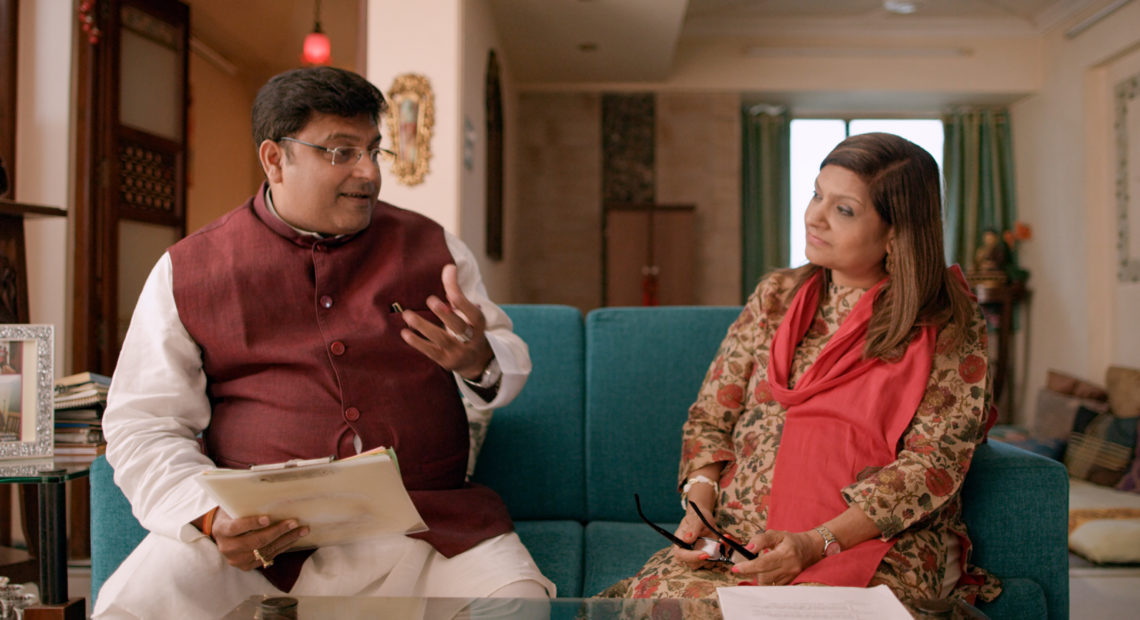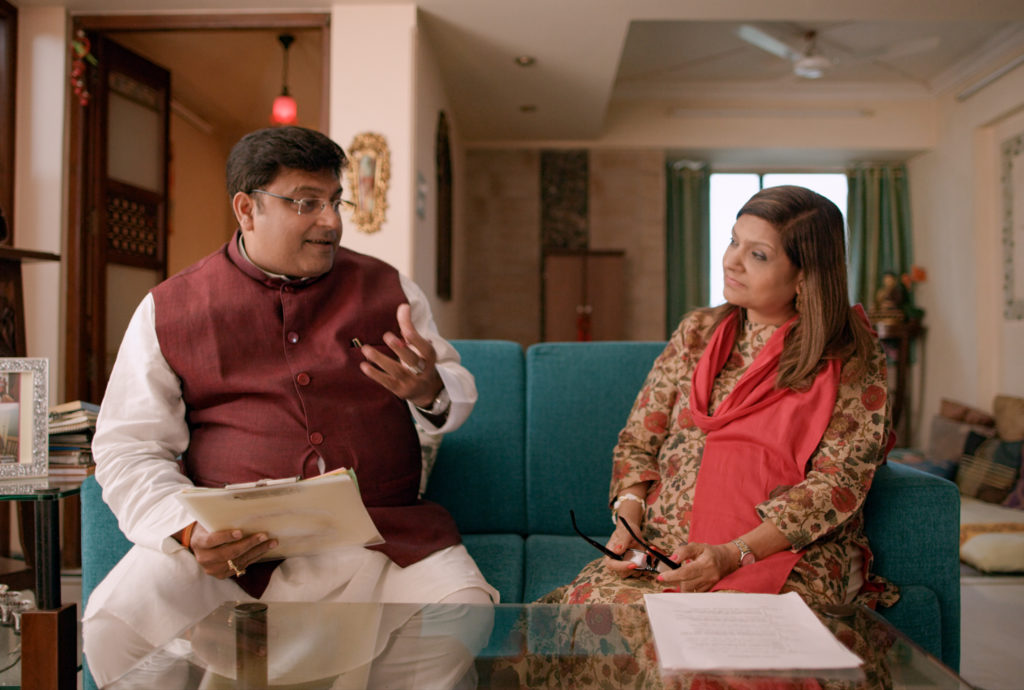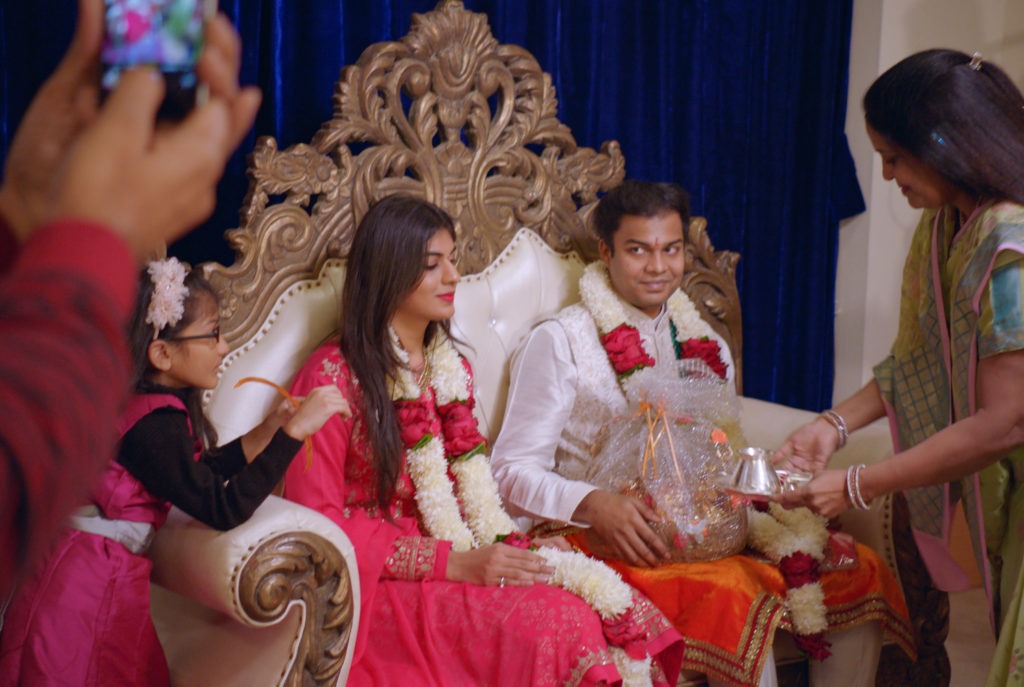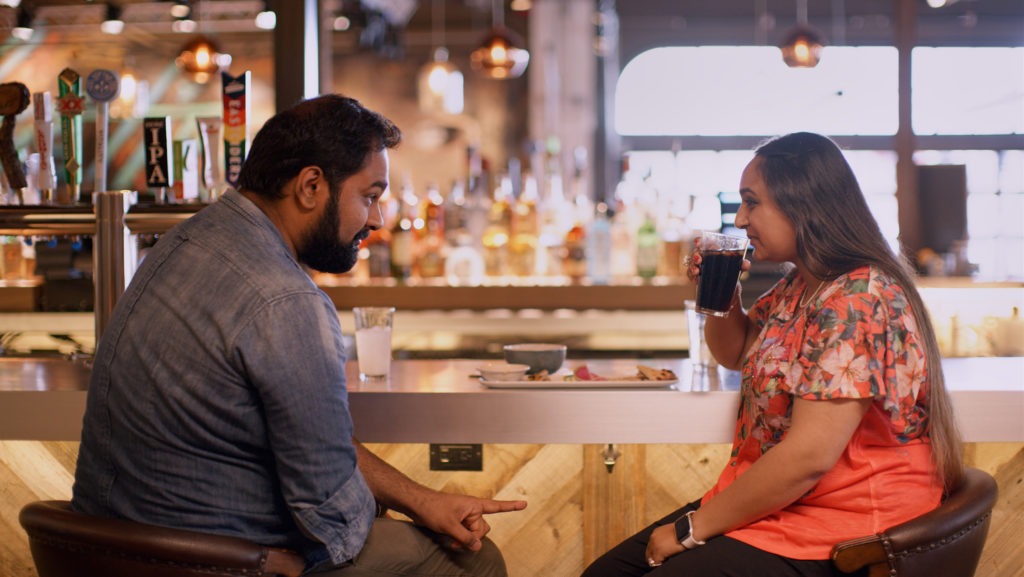
Netflix’s ‘Indian Matchmaking’ Is The Talk Of India — And Not In A Good Way
BY SUSHMITA PATHAK
A picky 25-year-old from Mumbai whose unwillingness to marry raises his mom’s blood pressure. A headstrong 34-year-old lawyer from Houston who says she doesn’t want to settle for just anybody. A cheerful 32-year-old Guyanese-American dancer with Indian roots who simply wants to find a good person to be her husband.
These are some of the singles on the new Netflix original series Indian Matchmaking, a reality TV show about arranged marriages in Indian culture. The show follows Sima Taparia, a professional matchmaker from Mumbai, as she jets around the world, quizzing clients on their preferences, handing them “biodatas” for potentially compatible mates (that’s the term she uses for what seem to be a cross between a resume and a dating profile), and ultimately introducing them to prospective spouses.

Sima Taparia (right) is a jet-setting matchmaker from Mumbai. Here she confers with astrologer Pundit Sushil ji, who helps her come up with prospective mates for her clients. CREDIT: Netflix
The eight-part series, which premiered on July 16, follows the participants as they navigate awkward first dates and meetings with the families of their matches. It became popular almost instantly in the U.S. — and in India. Indian social media is flooded with memes of Taparia’s one-liners (“Ultimately, my efforts are meaningless if the stars are not aligned”). Brands are using show references in ads.
But the series has also sparked a debate about arranged marriage and is drawing criticism for its portrayal of the practice – as well as for seeming to endorse gender stereotypes, colorism and classism. The makers of the show are facing a backlash on social media for failing to challenge the regressive beliefs that some participants espouse and state openly. The 57-year-old elite marriage consultant is being criticized as well.
“The show gave Taparia, whose version of arranged marriage is [very outdated], free rein to peddle whatever she was saying as fact,” says film critic Poulomi Das.
‘Life Is Never Equal’
Throughout the series, female participants are encouraged to be flexible and submissive. Taparia advises her female clients to “adjust and compromise” when it comes to choosing their life partner. When Aparna Shewakramani, the headstrong lawyer, rejects her first match because he is not ambitious and would never move somewhere that didn’t have an ocean nearby, Taparia says “she should not get a life partner if she is this negative.”
Taparia’s colleague tells another female client that she should be ready to uproot herself and move to another country, leaving behind career, family and friends, if her future husband asks her to. “Life is never equal,” she tells the woman with a smile.
When a client is confused or indecisive, Taparia ropes in life coaches, astrologers and face readers — someone who looks at a picture and predicts compatibility or, in one case, twin births if there is a marriage.
#IndianMatchmaking has normalised sexism, casteism, fatphobia and colorism too. I recommend it a 100% for hate-cringe-binge-watching. #Netflix#indianmatchmakingnetflix
— Anushka (@nushkaykay) July 23, 2020
The participants dissect their dates with friends and family and suffer romantic setbacks. In the last episode, Akshay Jakhete, the picky 25-year-old, even has a lavish pre-engagement ceremony with one of his matches.
In a memorable scene from an earlier episode, Jakhete’s mom chides him for being fussy and says his older brother and sister-in-law wouldn’t have a baby until he was married — so he’s to blame for their delay.
“What did I do?” a slightly taken-aback Jakhete asks.
Soooo who wants to join me in sending complaints to @NetflixIndia about the blatant #casteism and #colorism in #IndianMatchmaking (and also being sexist so much ugh)
This is where we can email I believe
content-complaints-india@netflix.com— Ishmeet Nagpal (@IshmeetNagpal) July 17, 2020
“The show has plenty of moments of secondhand embarrassment, which makes it great reality TV,” says Das. “[But] it’s impossible to be a single woman in India and watch it without being triggered.”
Nikita Doval, a 39-year-old writer, says she felt triggered just a few minutes into the first episode. Doval went through a tough period in her 20s when her parents were trying to arrange her marriage.
Men would ask her to make up her mind based on a short first meeting. One highly-educated man asked her if she was a virgin. Another, whom she was briefly engaged to, would get angry if she called him by his name because he considered it disrespectful.
“I had three or four panic attacks,” Doval says. “Every ring of the phone used to make the bottom of my stomach fall out thinking, ‘Oh my god, is it the boy’s family calling to ask [if I’ve made a decision.]”
The Dark Origins Of Arranged Marriage
Critics say one of the show’s biggest flaws is that it glosses over the dark roots of arranged marriage and glorifies it as a harmless, quirky alternative to dating.
Four out of five Indians have arranged marriages, which typically occur within the rigid bounds of Hinduism’s ancient caste system — roughly based on a hierarchy of professions people are born into. When people start looking for a spouse for their son or daughter, the candidates they shortlist are usually from their own caste. Indian newspapers are filled with matrimonial ads seeking matches from a particular caste.

Akshay Jakhete (right) is matched up.
CREDIT: Netflix
It’s a way “to ensure that the caste bloodline remains “pure” and is not contaminated by the impure blood of lower castes.” writes Suraj Yengde, an activist and scholar on caste.
Inter-caste marriages are rare in India today and often provoke familial violence. Dozens of Indians are murdered each year — often by family members or in-laws — for marrying outside their caste.
Social reformers have promoted inter-caste marriage as a way to end the caste system. There are NGOs that help inter-caste and inter-faith couples who may be in danger. The state of Haryana has a scheme to encourage inter-caste marriages wherein the couple gets a cash incentive if one of them is from a lower caste.
“Resilient targeted efforts are necessary to promote inter-caste marriage, which may loosen the noose of the caste system in India,” write population studies experts Pralip Kumar Narzary and Laishram Ladusingh.
The Meaning Of ‘Fair’
Several times in the series, Taparia, while talking about a promising match, casually mentions “fair-skinned” as one of their good qualities. While rattling off her preferences, one Indian-American participant says she’s looking for someone who’s “not too dark, you know, fair-skinned.”
In India, colorism is rampant. The faces of popular celebrities and billboard models are typically light. So darker-skinned Indians are made to feel insecure — and also face discrimination.
“A woman’s dark skin can preclude her from entering positions such as news anchor, sales associate, flight attendant and even receptionist because these jobs require exposure to and interaction with the public, who will judge her as unattractive, unworthy and incompetent,” notes a 2015 journal report compiled by academics Cynthia Sims and Malar Hirudayaraj.
Skin-whitening products make up half of all skin-care products in India, according to the World Health Organization. In Indian movies, men sing about how a woman’s pale skin makes them swoon.

Is it a match? A potential couple meet up courtesy of a matchmaker in the Netflix series Indian Matchmaking.
CREDIT: Netflix
But the show doesn’t give any context about this prejudice, Das points out: “An obsession with fair skin can’t be a preference. It is a harmful, regressive brutality.”
In recent years, as the Black Lives Matter movement has grown, more Indians have been questioning the bias against dark skin. In June, consumer goods giant Unilever announced it was dropping the word “fair” from the name of its popular Fair & Lovely product, which has been on Indian grocery store shelves since 1975.
‘Not Far From Reality’
While most people on social media criticize the show or make fun of it, some credit it for exposing the social evils that exist in Indian society.
“My hope is that it will spark a lot of conversations that all of us need to be having in the South Asian community with our families — that it’ll be a jumping off point for reflections about the things that we prioritize, and the things that we internalize,” Smriti Mundhra, the executive producer of the show, said in an interview with decider.com.
“This show is not far from reality,” sociologist Parul Bhandari wrote in an op-ed. “We are perhaps uncomfortable and angry because this show has said it as it is, and has done so on a global platform, leaving little scope for pretense.”
The show lays bare the hypocrisy of many seemingly progressive Indians, says Amita Nigam Sahaya, a gender activist and author of The Shaadi Story: Behind the Scenes of the Big Fat Indian Wedding.
“We’ve given all the tools [to women] vis-a-vis education, thought processes, financial autonomy,” Sahaya says. “But the moment she reaches a particular point in her 20s or 30s when she gets into a partnership with a man, we say now it’s time for you to take 100 steps back into a very traditional role.”
Older generation Indians, like her parents, are also not entirely at fault, says Doval. If they hadn’t tried to arrange her marriage, society would have accused them of being bad parents, she says.
When Doval posted a Twitter thread about her own experience with arranged marriage, she received scores of messages from strangers, especially young women, seeking advice.
“Some of them had given in to the system, some of them were holding out, some wanted to know, ‘How exactly did you say no?’ or ‘How did you convince your parents?’ ” Doval says.
She’s been reassuring them, telling them they’re not alone and that standing up for themselves doesn’t make them bad.
“That’s what feminism is at the end of the day,” says Doval. “Women standing up for each other and saying I’ve got your back.”
9(MDAyOTk4OTc0MDEyNzcxNDIzMTZjM2E3Zg004))















